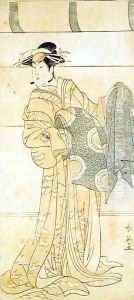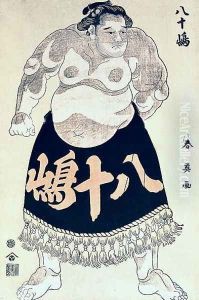Katsukawa Shunyei Paintings
Katsukawa Shunyei, born in 1762, was a Japanese ukiyo-e artist, particularly known for his prints of sumo wrestlers and kabuki actors. He was a pupil of Katsukawa Shunsho, who was a prominent figure in the Katsukawa school, which focused on depictions of the entertainment districts of Edo (modern-day Tokyo). Shunyei adopted the style and subjects popularized by his master, contributing to the rich tradition of Japanese woodblock prints.
Shunyei's works are characterized by their dynamic composition and vivid portrayal of the theatrical world. He captured the drama and energy of sumo wrestling and kabuki theater, which were popular forms of entertainment during the Edo period. His prints of sumo wrestlers are particularly valued, as they constitute some of the earliest and most significant visual records of the sport during that era.
Despite the popularity of his subjects, relatively little is known about Shunyei's personal life. Like many ukiyo-e artists, he focused on the commercial aspects of his craft, producing prints that catered to the tastes of Edo's urban middle class. His work contributed to the development of the nigao-e or 'likeness picture', which aimed to capture the individual characteristics of actors, a technique that would become highly influential in the genre of actor prints.
Shunyei continued to produce art throughout his life, and his career spanned a particularly vibrant period in the history of ukiyo-e, overlapping with the careers of other great artists such as Utamaro and Sharaku. He passed away in 1819, leaving behind a legacy that would influence future generations of Japanese printmakers. His works are now considered important cultural artifacts that offer insights into the popular culture and visual aesthetics of the Edo period.

